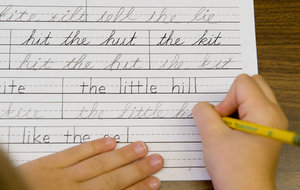In elementary school, I learned to write in cursive. Now in college, I don’t even buy pens as a school supply because I type everything. Thank goodness that’s the case or else no one would be able to read my work! But, this brings up a pretty common, though fairly useless, debate: Should students in the U.S. public elementary school system still be taught to write in cursive?
On one hand, there is merit in the belief that cursive writing is of absolutely no use in the practical world, where most tasks are completed electronically. Logically, it follows that a shift toward technological education should take precedent.
On the other hand, there are those who feel that learning to write in cursive is a major benefit to cognitive brain development in children. For instance, the National Association of State Boards of Education (NASBE) came out with a Policy Update in September 2012, in which they presented evidence that supports the aforementioned claim.
The NASBE report opens with the explanation that the Common Core State Standards (CCSS) lack guidelines for cursive handwriting. In fact, the CCSS are structured to emphasize keyboard skills instead. The CCSS are a result of an effort led by the National Governors Association (NGA) and the Council of Chief State School Officers (CCSSO).
So naturally, when states began adopting the CCSS in 2010, the debate of whether or not to include handwriting standards slowly developed among members of state education boards.
Indiana State Senator Jean Leising said to the IndyStar that she agrees with the assertion that cursive writing improves motor skills, memory and brain development.
The article implies that it is because of this reason she has successfully convinced her state’s Senate to advance a bill that requires the state’s public education system to teach students to write in cursive.
Indiana is one of a handful of states — along with California, Georgia, Alabama and Massachusetts — to be mentioned in the NASBE update. These states fought to keep handwriting standards in their education system, per the specifications of the CCSS.
The CCSS Initiative website’s home page explains that the goal is to better prepare students once they enter college courses and the work force. A secondary goal is to improve the U.S.’s international standing in terms of elementary education.
I would argue that the CCSS were put together as a response to studies from several years that showed that the U.S. ranked lower and lower in terms of math, science and English education in a global comparison.
Last December, NPR ran a report that detailed the results of the Program for International Student Assessment (PISA).
The report explained the latest assessment from 2012, which found that U.S. high school students ranked below average in math, though they were close to average in reading and science.
Bringing it back to our worthless debate: If American students are performing better in reading than they are in math, then why would we worry about teaching them cursive?
Clearly math literacy is the subject that needs more attention, not literacy itself.
I think a more productive conversation would be to talk about requiring students to memorize the old-school times tables chart, something the Common Core State Standards do not even mention.
There is only a little bit of wiggle-room for states to include their own standards along with the CCSS, and it seems to me that the states reclaiming a handwriting standard for their youths are playing up the possibility of a relationship to brain development in order to justify an emotional waste of time.
For example, North Carolina’s “Back to Basics” bill, signed into law in 2013, requires all students in the state’s public education system to learn to write proficiently in cursive by the end of their fifth grade year. Why?
In an article released by the Today Show, North Carolina State Rep. Patricia Hurley, who co-sponsored the bill, said she received many thank-you notes from fourth grade students printed from computers.
“It struck me as strange that they weren’t writing … It was like these kids weren’t educated.”
In other words, her fundamental, perhaps somewhat sentimental, attachment to the old-fashioned writing style drove the state to add the cursive element to the already rigorous and complex Common Core State Standards.
Yes, I do know how to write in cursive. Yes, I use it more than I use ordinary hand-writing. But, given the choice between that and typing, for a professional document, I would choose a keyboard.
Typing is faster, cleaner, and easier to transport. Now let’s talk about math.




